

Oxford Journals.
Cerebral Cortex. A locus on 2p12 containing the co-regulated MRPL19 and C2ORF3 genes is associated to dyslexia. + Author Affiliations *To whom correspondence should be addressed.

Tel: +46 86089158; Fax: +46 87745538; Email: juha.kere@biosci.ki.se Received December 7, 2006. Accepted February 2, 2007. Abstract DYX3, a locus for dyslexia, resides on chromosome 2p11-p15. Developmental dyslexia is a specific disorder in learning to read and spell in spite of adequate educational resources, normal intelligence, no obvious sensory deficits and adequate sociocultural opportunity. Dyslexia is strongly familial, and abundant evidence supports genetic factors in its etiology (6). Three independent genome-wide scans using different analytical approaches have shown linkage of dyslexia to 2p12-p16 (14–16). In our previous genome-wide scan on 11 Finnish pedigrees, we identified linkage to the broad Chromosome 2 DYX3 locus using a categorical phenotype (16). Linkage disequilibrium mapping of the 2p12 dyslexia candidate region in Finnish families Figure 1. Physical map over the 2p12 dyslexia candidate region.
An Investigation of Methods to Detect Feigned Reading Disabilities. + Author Affiliations *Corresponding author at: Department of Psychology, Queen's University, Kingston, Ontario, Canada K7L 3N6.
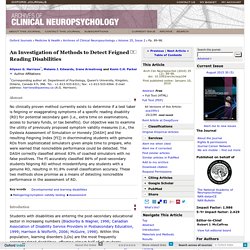
Tel.: +1-613-533-6311; fax: +1-613-533-6564. E-mail address: harrisna@queensu.ca (A.G. Harrison). Abstract No clinically proven method currently exists to determine if a test taker is feigning or exaggerating symptoms of a specific reading disability (RD) for potential secondary gain (i.e., extra time on examinations, access to bursary funds, or tax benefits). Introduction. Auditory processing and the development of language and literacy. Abstract This paper considers evidence for basic auditory processing impairments associated with dyslexia and specific language impairment, against a back-drop of findings from studies of the normal development of auditory and phonological processing.

A broad range of auditory impairments have been implicated in the aetiology of these language-learning disorders, including deficits in discriminating the temporal order of rapid sequences of auditory signals, elevated thresholds for frequency discrimination and for detection of amplitude and frequency modulation, impaired binaural processing and increased susceptibility to backward masking. Current evidence is inconsistent, but suggests that not all children with language difficulties have non-verbal auditory processing impairments, and for those that do, the impact on language development is poorly understood. Some implications for clinical practice are discussed.
Convergence of Visual and Tactile Shape Processing in the Human Lateral Occipital Complex. + Author Affiliations Address correspondence to Amir Amedi, Neurobiology Department, Life Science Institute, Hebrew University, Jerusalem 91904, Israel.
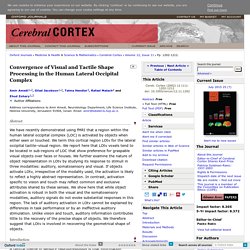
Email: amir@lobster.ls.huji.ac.il. Abstract We have recently demonstrated using fMRI that a region within the human lateral occipital complex (LOC) is activated by objects when either seen or touched. We term this cortical region LOtv for the lateral occipital tactile–visual region. Introduction. Developmental Coordination Disorder. Skip to Main Content Sign In Register Advanced Search Online ISSN 1538-6724 Print ISSN 0031-9023 Copyright © 2017 American Physical Therapy Association Connect Resources Explore.
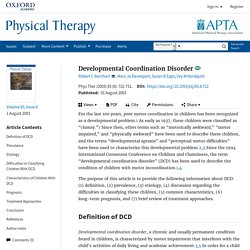
Feasibility and Efficacy of a Computer-Based Intervention Aimed at Preventing Reading Decoding Deficits Among Children Undergoing Active Treatment for Medulloblastoma: Results of a Randomized Trial. Skip to Main Content Sign In Register Advanced Search.
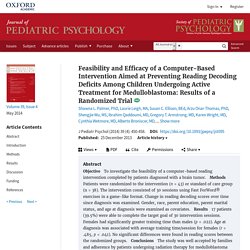
Forgetting emotional material in working memory. Skip to Main Content Sign In Register Close.
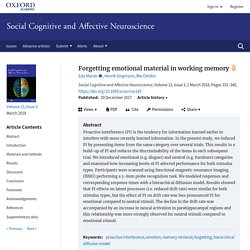
Functional genetic analysis of mutations implicated in a human speech and language disorder. Abstract Mutations in the FOXP2 gene cause a severe communication disorder involving speech deficits (developmental verbal dyspraxia), accompanied by wide-ranging impairments in expressive and receptive language.
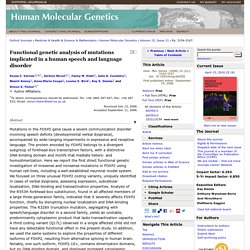
The protein encoded by FOXP2 belongs to a divergent subgroup of forkhead-box transcription factors, with a distinctive DNA-binding domain and motifs that mediate hetero- and homodimerization. Hearing Loss and Cognition Among Older Adults in the United States. Skip to Main Content.
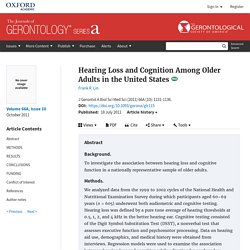
How Localized are Language Brain Areas? A Review of Brodmann Areas Involvement in Oral Language. Skip to Main Content Sign In Register Advanced Search.
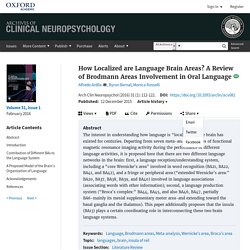
Music-induced positive mood broadens the scope of auditory attention. We use cookies to enhance your experience on our website. By clicking 'continue' or by continuing to use our website, you are agreeing to our use of cookies. You can change your cookie settings at any time. Skip to Main Content. Philosophy of science and the diagnostic process. + Author Affiliations ↵*Correspondence to Brian H Willis, Primary Care Clinical Sciences, University of Birmingham, Edgbaston, Birmingham B15 2TT, UK; E-mail: b.h.willis@bham.ac.uk Abstract This is an overview of the principles that underpin philosophy of science and how they may provide a framework for the diagnostic process.
Although philosophy dates back to antiquity, it is only more recently that philosophers have begun to enunciate the scientific method. Reading Mechanisms in Orally Educated Deaf Adults. Retrocochlear function of the peripheral deafness gene Cacna1d. + Author Affiliations ↵*To whom correspondence should be addressed at: Department of Neurogenetics, Carl von Ossietzky University Oldenburg, 26111 Oldenburg, Germany.
Tel: +49 4417983932; Fax: +49 4417985649; Email: hans.g.nothwang@uni-oldenburg.de Received April 12, 2012. Accepted May 30, 2012. Abstract Hearing impairment represents the most common sensory deficit in humans. The Development of Audiovisual Multisensory Integration Across Childhood and Early Adolescence: A High-Density Electrical Mapping Study. + Author Affiliations Address correspondence to Dr Sophie Molholm, Departments of Pediatrics and Neuroscience, Albert Einstein College of Medicine, Van Etten Building—1C, 1225 Morris Park Avenue, Bronx, NY 10461.
Email: sophie.molholm@einstein.yu.edu. The genetic basis of the joint hypermobility syndromes. Rheumatologists have long considered that joint hypermobility is inherited. Too Little, Too Late: Reduced Visual Span and Speed Characterize Pure Alexia. Pure alexia is an acquired reading disorder that leaves writing unaffected.
Pure alexic reading is usually slow with single-word reading characterized by a pronounced word length effect; reaction times (RTs) in reading increase linearly with word length, often with hundreds of milliseconds per letter (Behrmann, Plaut, and Nelson 1998). Theories of pure alexia can be roughly divided into 2 groups: 1) Domain-specific accounts, suggesting that pure alexia arises due to damage to a cognitive system or cerebral area specialized for recognizing visual word forms (Warrington and Shallice 1980; Warrington and Langdon 1994; Cohen et al. 2003; Cohen and Dehaene 2004); 2) General visual accounts, claiming that pure alexia reflects a general deficit in visual perception (Farah and Wallace 1991; Behrmann, Nelson, and Sekuler 1998), often conceptualized as a primary impairment in simultaneous perception or parallel processing (Farah, 2004).
Methods.